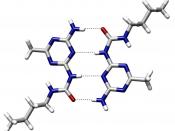Write an essay on intermolecular bonding. Explain how each type of bond arises and the evidence for the existence of each. Comment on their strengths in relation to the types of atoms involved; the covalent bond and relative to each other. Use the concepts of different types and strengths of intermolecular bonds to explain the following:
There exists four types of intermolecular bonding, they include ionic, covalent, Van der waals and hydrogen bonding. In order to describe the existence of such bonding you must also understand the concepts of polarity, polar and non-polar, and electronegativity.
Ionic bonds are created by the complete transfer of electrons from one atom to another. In this process of electron transfer, each atom becomes a ion that is isoelectronic with the nearest noble gas., the substance is held together by electrostatic forces between the ions. The tendency for these ions to be formed by elements is corespondent to the octet rule, when atoms react,, they tend to do so in such a way that they attain an outer shell containing eight electrons.
The factors that effect the formation of ions are ionization energy, electron affinity, lattice energy.
Figure 1
The transfer of electrons involved in the formation of (a) sodium chloride and (b) calcium fluoride. Each atom forms an ion with an outer shell containing eight electrons.
For many elements, compounds cannot be formed by the production of ions, since the energy released in the formation of the lattice of ions would be insufficient to overcome the energy required to form the ions would be insufficient to overcome the energy required to form the ions in the first place. In order for the atoms to achieve a noble gas configuration they must use another method of bonding by the process of electron sharing. From figure...


